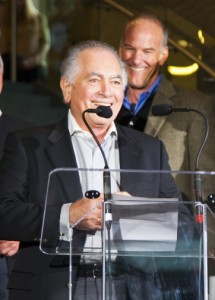Western Growers’ Center For Innovation & Technology To Focus On Labor, Water Solutions

Tom Nassif
In today’s world, if you’re not thinking ahead, you’re being left behind. Innovation is key if you want to stay competitive in your marketplace, particularly in agriculture where resources are diminishing and demand is steadily increasing.
To help tackle the challenge of growing in such paradoxical conditions, the Western Growers Association (WGA) recently established the Western Growers Center for Innovation & Technology.
The center, located in Salinas, CA, is a gathering place for innovators, farmers, and investors to come together and brainstorm solutions to agriculture’s biggest challenges. Technology is at the forefront of the center’s focus, and solutions to labor, water conservation, food safety, and sustainability are all on the docket.
Here, WGA’s President, Tom Nassif, answers a few questions about the new center and where it is headed over the next 10 years.
Q1 Why did WGA create the center?
Nassif: In an era of diminishing natural and human resources and growing regulatory and marketplace demands, the future of agriculture depends on technology. We decided — perhaps as an industry — we could develop technology that would help many producers, especially in the specialty crop industry, to find technology to solve some of the problems they’ve been unable to solve, or that have been too expensive to implement.
These innovative solutions will help farmers feed more people with fewer inputs.
Q2 What are some of your major goals?
Nassif: With the reduction in labor and water, we have to turn to technology to find more effective ways to conserve and do more with less. This could mean using less (water), by keeping more of it in the root system, or by using alternative methods of irrigation.
We’re also looking at automation — robotics for example. We’re looking at any way we can reduce the need for manual labor, especially with no immigration reform in sight.
Q3 How will the center facilitate communication between members?
Nassif: We’ve built up a center where 30 to 35 different individual entrepreneurs, innovators, or com-panies can have an office with all of the technology that’s needed in a workplace. The concept is they have an opportunity to collaborate with other innovators who might have a partial answer, and with that partial answer may be able to solve a perplexing problem for farmers.
It’s also a place where they can meet the farmers to determine whether or not their innovation is commercially viable, and to be able to alter it to meet the needs of the eventual customers. They also can meet investors who might be interested in helping fund the development of their particular innovation. It’s a place where innovators meet investors and creativity meets commerce.
Q4 How does your innovation center differ from similar centers?
Nassif: There’s nothing that rivals what we’re doing, in part because of the location. Other innovation centers are in or near Silicon Valley and San Francisco. We’re right in the heart of the farming area where they can meet with local farmers on a regular basis, and they’re close enough to the Bay Area and the Silicon Valley to be able to draw investors to the center.
An additional thing we do is help start-ups get seed money, or if they’re past the seed money stage, get investor money to grow and develop their company. In fact, many Western Growers’ members are investing in these technologies and companies.
Q5 What key projects are currently being worked on?
Nassif: The companies are tackling food waste, water problems, labor problems, and finding ways to examine fields without having to be physically located there. There also are projects aimed at being able to track management and farming practices through software, and the ability to create various types of packaging.
Q6 You said one of the big areas of interest is mechanization. What do you have planned in that category?
Nassif: Several companies are working on technologies for thinning the crops, harvesting crops, being able to examine whether or not crops are ripe for picking, and picking without bruising or in any way damaging the produce they’re harvesting.
We have found several companies who have similar technologies, and some have part of the answer but maybe a part of it is with another two or three companies. One of the aspects we’re trying to do is to get some of these manufacturers and innovators to work together to create a product using their combined technologies for the better of the entire industry.
That’s the advantage of being in the center. So many companies have realized that it’s so expensive to develop their technology, and the best way to do it is in concert with other people who have the same needs.
Q7 What specific challenges are growers coming to you with?
Nassif: Ways to reduce labor, because that’s one of the most vexing problems we face in agriculture. But of course, without adequate water, labor is not a problem. Assuming you have an adequate water supply, how do you get your crops planted?
On the sustainability side, there’s a lot of interest in trying to reduce inputs, for example [the use of] fertilizers and other crop protection tools. We’d like to find ways to reduce that need, or use fertilizers that are recycled. For example, recycling food waste into liquid fertilizer — that helps us avoid wasting food and gives us a wonderful tool for growing our crops.
Q8 Where do you see the center headed within the next five to 10 years?
Nassif: I see us doing more mentoring and teaching in the centers to help young startups understand how to protect themselves legally through patents. And as they bring in investors, how to make sure they end up owning a good piece in their company.
If the demand is there, we will add additional innovation centers regardless of what state they’re in. We want to provide everyone an opportunity to meet with these innovators. We don’t want to limit that to growers in the Salinas area. We want to make sure people all over the U.S. can come together and benefit from technology.









